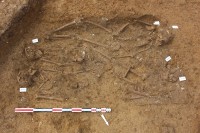 A team of archaeologists with France’s National Institute of Preventative Archaeological Research (INRAP) have unearthed shackled skeletons from a Gallo-Roman necropolis in Saintes, southwestern France. The property was slated for construction of a detached home and an archaeological survey of an adjacent plot last year found evidence of ancient funerary usage. From September to November of this year, the excavation discovered 100 graves dating to the 1st and 2nd centuries A.D.
A team of archaeologists with France’s National Institute of Preventative Archaeological Research (INRAP) have unearthed shackled skeletons from a Gallo-Roman necropolis in Saintes, southwestern France. The property was slated for construction of a detached home and an archaeological survey of an adjacent plot last year found evidence of ancient funerary usage. From September to November of this year, the excavation discovered 100 graves dating to the 1st and 2nd centuries A.D.
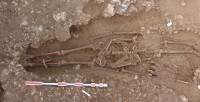 These were very modest burials. Most of the graves contain double burials, two people buried head to toes in rectangular trenches. One grave was a multiple with five people, two of them adult women and two of them children. Only one of them included any grave goods: a small child buried with seven vases and a coin over each eye to pay the ferryman conveying him over the river into the underworld. The vases date to the second half of the 2nd century A.D. which makes this burial with a funerary practice entirely different from the others one of the later graves in the necropolis.
These were very modest burials. Most of the graves contain double burials, two people buried head to toes in rectangular trenches. One grave was a multiple with five people, two of them adult women and two of them children. Only one of them included any grave goods: a small child buried with seven vases and a coin over each eye to pay the ferryman conveying him over the river into the underworld. The vases date to the second half of the 2nd century A.D. which makes this burial with a funerary practice entirely different from the others one of the later graves in the necropolis.
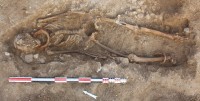 Perhaps the most intriguing discovery were the remains of five shackled individuals. Three of them are adult men, one is an adult of unknown gender and one is a child. Of the four adults, three had iron shackles hot riveted to their left ankles alone. The fourth had a shackle on the right ankle and a larger one, known as a “bondage collar” or “straitjacket,” around his neck. The child had a shackle on his or her left wrist that was more rudimentary than the ones the adults were made to wear into eternity. It’s flat and curved around the wrist where the ends are riveted together.
Perhaps the most intriguing discovery were the remains of five shackled individuals. Three of them are adult men, one is an adult of unknown gender and one is a child. Of the four adults, three had iron shackles hot riveted to their left ankles alone. The fourth had a shackle on the right ankle and a larger one, known as a “bondage collar” or “straitjacket,” around his neck. The child had a shackle on his or her left wrist that was more rudimentary than the ones the adults were made to wear into eternity. It’s flat and curved around the wrist where the ends are riveted together.
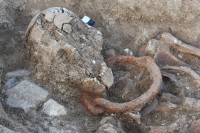 Individuals with shackles have been found before from this period in France, but this discovery is notable for having five of them. The adult shackled around the neck and ankle is also unusual. Researchers are hoping to find out more about these people’s lives and deaths by analyzing the human remains, artifacts and shackles. Ideally they’d like to discover the cause of death for all the interred, what kind of food they ate, what kind of work they did, whether they lived together in the same community. If they came from the same place, or at least lived in similar conditions, the bones and teeth will attest to that.
Individuals with shackles have been found before from this period in France, but this discovery is notable for having five of them. The adult shackled around the neck and ankle is also unusual. Researchers are hoping to find out more about these people’s lives and deaths by analyzing the human remains, artifacts and shackles. Ideally they’d like to discover the cause of death for all the interred, what kind of food they ate, what kind of work they did, whether they lived together in the same community. If they came from the same place, or at least lived in similar conditions, the bones and teeth will attest to that.
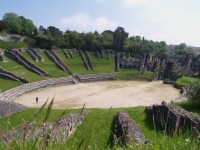 Saintes, known in antiquity as Mediolanum Santonum, was an important regional center in the Roman province of Aquitania. It was founded around 20 B.C. when the Roman roads connecting to Burdigala (modern-day Bordeaux) with its copious tin and lead trade to other towns in the region were expanded. Built at the western end of the Via Agrippa, the major artery that linked Lugdunum (Lyon) to the Atlantic coast, Saintes quickly became thoroughly Romanized with monumental public architecture and utilities.
Saintes, known in antiquity as Mediolanum Santonum, was an important regional center in the Roman province of Aquitania. It was founded around 20 B.C. when the Roman roads connecting to Burdigala (modern-day Bordeaux) with its copious tin and lead trade to other towns in the region were expanded. Built at the western end of the Via Agrippa, the major artery that linked Lugdunum (Lyon) to the Atlantic coast, Saintes quickly became thoroughly Romanized with monumental public architecture and utilities.
The necropolis is 270 yards west of the great Roman amphitheater of Saintes. Large enough at its greatest extent to seat 12,000-18,000 people, the amphitheater is one of the largest and oldest in France today. Construction began during the reign of the emperor Tiberius (14-37 A.D.) and was finished around 41 A.D., under the reign of Claudius. As Roman amphitheaters generated significant death both in the construction phases and in their express purpose, it’s possible that the dead of the necropolis were somehow related to the amphitheater.